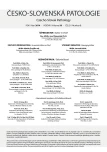-
Medical journals
- Career
WHO classification of tumours of soft tissue and bone 2013: the main changes compared to the 3rd edition
Authors: Iva Zambo; Karel Veselý
Authors‘ workplace: I. patologicko-anatomický ústav LF MU a FN u sv. Anny v Brně
Published in: Čes.-slov. Patol., 50, 2014, No. 2, p. 64-70
Category: Reviews Article
Overview
In early 2013, the new classification of tumours of soft tissue and bones was released. This edition belongs to the fourth series of so-called Blue Books published under the auspices of the World Health Organisation (WHO). The current classification follows the previous third edition, from which it differs in several aspects. The vast majority of changes are related to the soft tissue tumour section, which was enriched with three new chapters, some entities or terms were removed, new diagnoses were introduced, and several tumours were reallocated to other categories. Albeit to a lesser extent, similar changes have occurred also in the classification of bone tumours. Compared to the previous edition, more detailed molecular and cytogenetic data were incorporated in the current issue. The rapidly increasing knowledge of the genetics of mesenchymal tumours allows us to make more accurate diagnoses as well as to better understand of the pathogenesis of these lesions. However, abundant molecular and cytogenetic data highlight an increasing problem of growing numbers of genetic overlaps even among quite different tumours. The coexistence of several grading systems of soft tissue tumours is another controversial issue mentioned in the recent WHO classification. The main advantages and limitations of the two most widely used grading systems are also discussed.
Keywords:
WHO classification – sarcoma – soft tissues – bones – tumour
Sources
1. Fletcher CDM, Unni KK, Mertens F, et al. World Health Organization Classification of Tumours. Pathology and Genetics of Tumours of Soft Tissue and Bone. IARC Press: Lyon 2002.
2. Fletcher CDM. The evolving classification of soft tissue tumours: an update based on the new WHO classification. Histopathology 2006; 48 : 3-12.
3. Fletcher CDM, Bridge JA, Hogendoorn PCW, et al. WHO classification of tumours of soft tissue and bone. 4th Ed, IARC Press: Lyon, 2013.
4. Fletcher CDM. The evolving classification of soft tissue tumours - an update based on the new 2013 WHO classification. Histopathology 2014; 64(1): 2-11.
5. Deyrup ET, Weiss SW. Grading of soft tissue sarcomas: the challenge of providing precise information in an imprecise world. Histopathology 2006; 48 : 42-50.
6. Chibon F, Lagarde P, Salas S, et al. Validated prediction of clinical outcome in sarcomas and multiple types of cancer on the basis of a gene expression signature related to genome complexity. Nat Med 2010; 16 : 781-787.
7. Lagarde P, Perot G, Kauffmann A, et al. Mitotic checkpoints and chromosome instability are strong predictors of clinical outcome in gastrointestinal stromal tumors. Clin Cancer Res 2012; 18 : 826-838.
8. Mills AM, Beck AH, Montgomery KD, et al. Expression of subtype-specific group 1 leiomyosarcoma markers in a wide variety of sarcomas by gene expression analysis and immunohistochemistry. Am J Surg Pathol 2011; 35 : 583-589.
9. Bosman FT, Carneiro F, Hruban HR, et al. WHO classification of tumours of the digestive system. IARC: Lyon 2010; 74-76.
10. Miettinen M, Lasota J. Gastrointestinal stromal tumors: pathology and prognosis at different sites. Semin Diagn Pathol 2006; 23(2): 70-83.
11. Yamaguchi T, Watanabe-Ishiiwa H, Suzuki S, Igarashi Y, Ueda Y. Incipient chordoma: a report of two cases of early stage chordoma arising from benign notochordal cell tumors. Mod Pathol 2005; 18 : 1005-1010.
Labels
Anatomical pathology Forensic medical examiner Toxicology
Article was published inCzecho-Slovak Pathology

2014 Issue 2-
All articles in this issue
- WHO classification of tumours of soft tissue and bone 2013: the main changes compared to the 3rd edition
- Molecular pathology of pulmonary carcinomas
- Gastrointestinal stromal tumor (GIST): Advances in 2013
- Hereditary thyroid carcinoma and its molecular diagnostics
- Where does Ewing sarcoma end and begin - two cases of unusual bone tumors with t(20;22)(EWSR1-NFATc2) alteration
- Epidermolytic hyperkeratosis of the vulva associated with basal cell carcinoma in a patient with vaginal condyloma acuminatum and vaginal intraepithelial neoplasia harboring HPV, type 42
- Use of archival formalin-fixed, paraffin-embedded (FFPE) tissue samples for molecular genetic analysis in diffuse large B-cell lymphoma (DLBCL)
- The current staging for uterine body malignancies and its importance for clinical practice
- Czecho-Slovak Pathology
- Journal archive
- Current issue
- Online only
- About the journal
Most read in this issue- WHO classification of tumours of soft tissue and bone 2013: the main changes compared to the 3rd edition
- Where does Ewing sarcoma end and begin - two cases of unusual bone tumors with t(20;22)(EWSR1-NFATc2) alteration
- The current staging for uterine body malignancies and its importance for clinical practice
- Epidermolytic hyperkeratosis of the vulva associated with basal cell carcinoma in a patient with vaginal condyloma acuminatum and vaginal intraepithelial neoplasia harboring HPV, type 42
Login#ADS_BOTTOM_SCRIPTS#Forgotten passwordEnter the email address that you registered with. We will send you instructions on how to set a new password.
- Career
